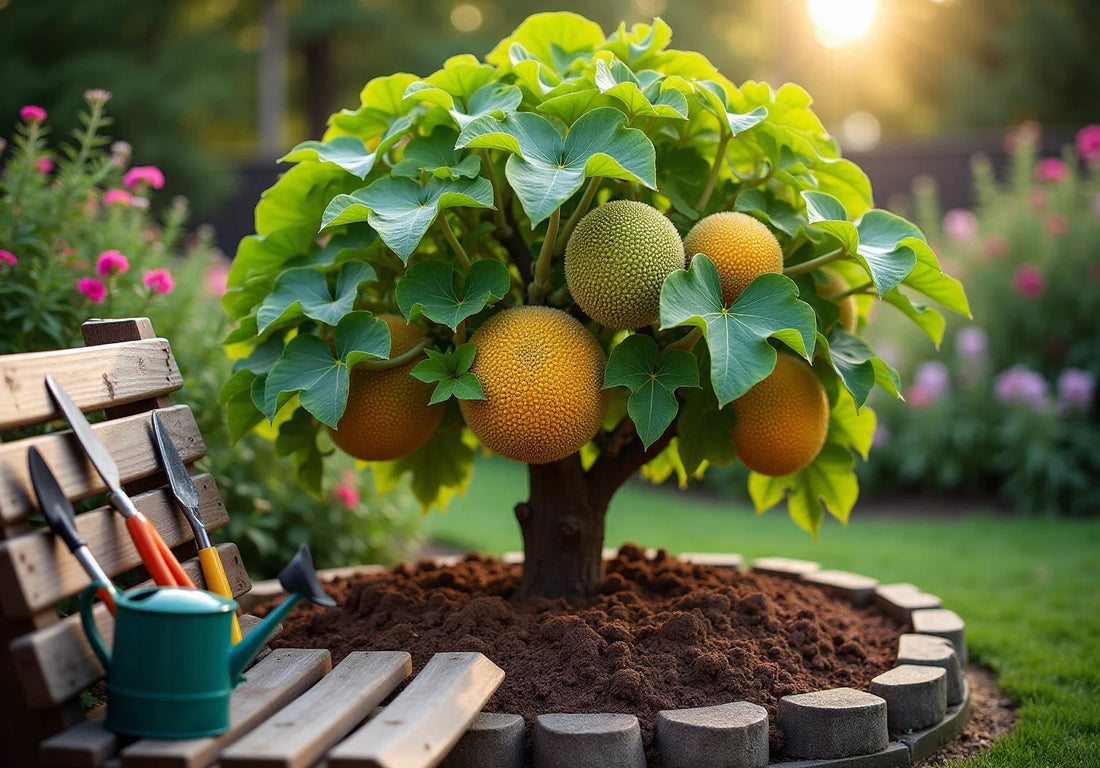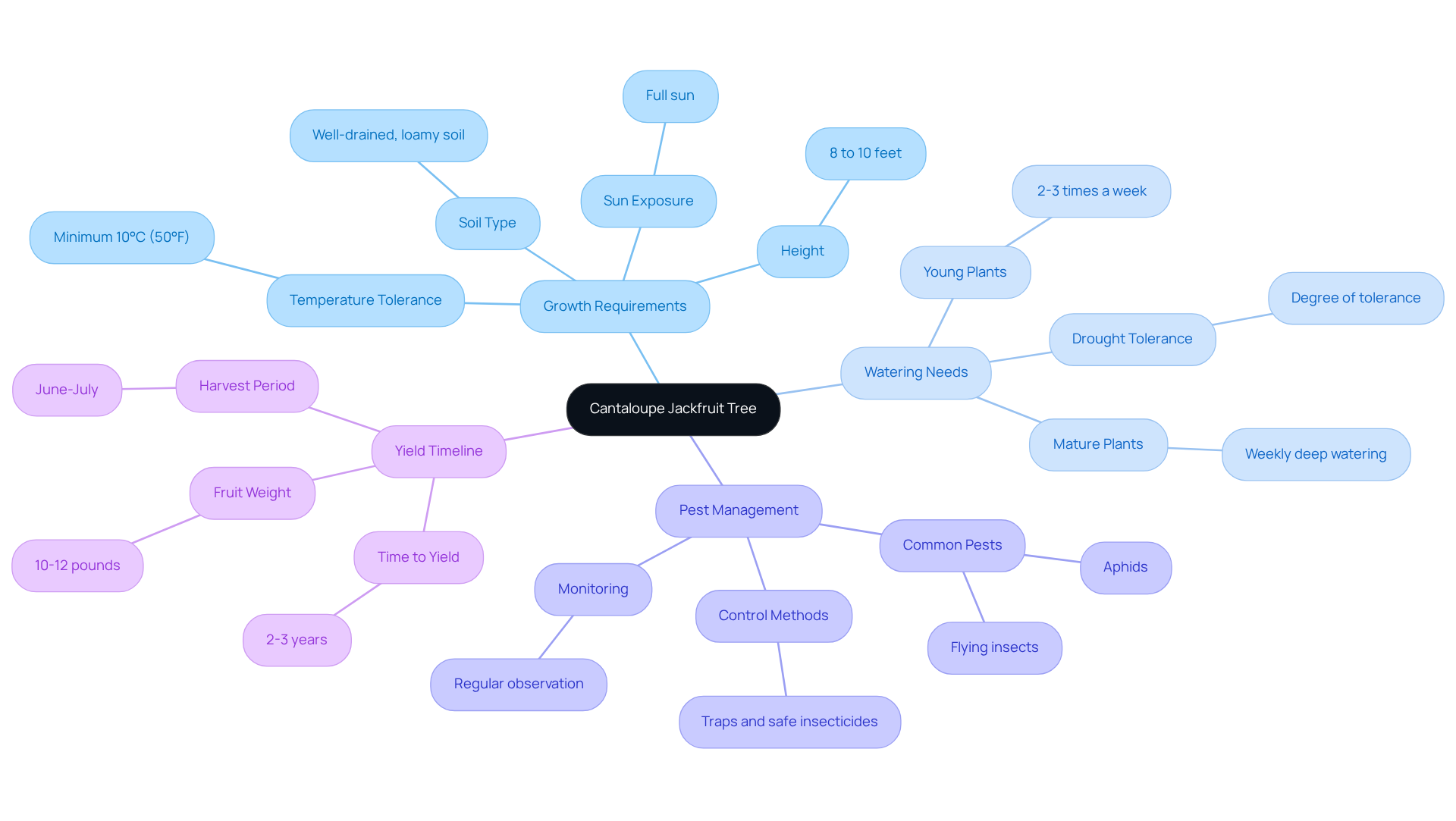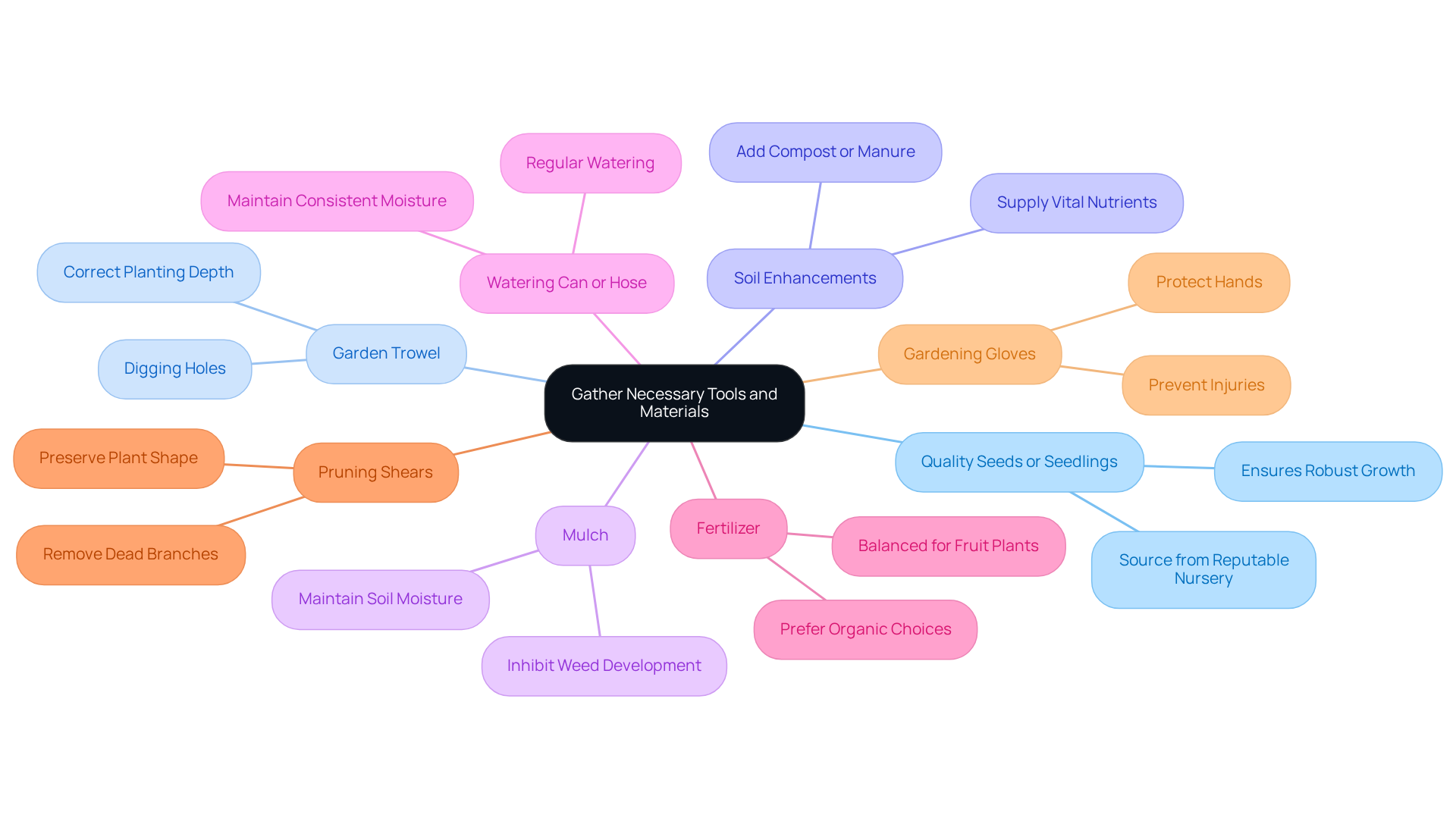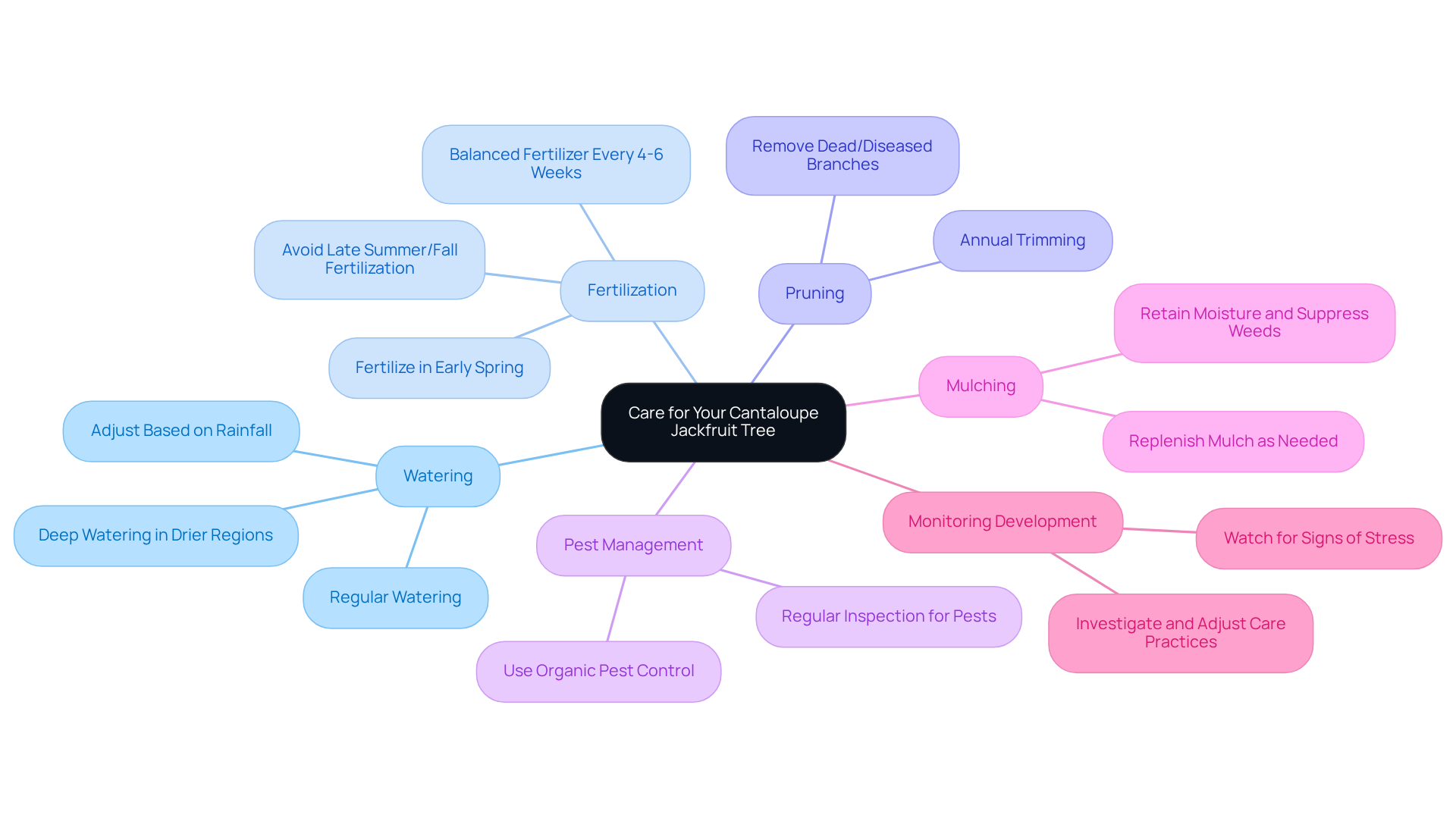
Step-by-Step Guide to Growing a Cantaloupe Jackfruit Tree
Share
The cantaloupe jackfruit tree, a remarkable hybrid of two cherished fruits, provides gardeners with a unique opportunity to cultivate a flavorful addition to their landscapes. This tree boasts impressive growth potential and a relatively swift yield timeline, making it both a rewarding challenge and a source of delicious produce.
However, what essential steps and considerations must be taken into account to successfully nurture this exotic plant and ensure its thriving presence in the garden?
This guide will explore the intricacies of growing a cantaloupe jackfruit tree, covering everything from planting techniques to troubleshooting common issues, thus empowering gardening enthusiasts to embark on their journey with confidence.
🥭 Thinking about growing a Jackfruit Tree in your garden?
Explore the Cantaloupe Jackfruit Tree for sale at Everglades Farm - shipped directly from Florida.
1. Understand the Cantaloupe Jackfruit Tree
The cantaloupe jackfruit tree, a hybrid of traditional jackfruit and cantaloupe, is celebrated for its distinctive fruit that melds the flavors of both. This tree typically reaches a height of 8 to 10 feet and flourishes in USDA Zones 9B to 11. It thrives in well-drained, loamy soil enriched with organic matter and requires full sun exposure for optimal development. Understanding its growth cycle, which encompasses a vegetative growth phase lasting 1 to 3 years, is crucial for successful cultivation.
During the early stages, young jackfruit plants should be watered 2-3 times a week until they establish strong roots. While the plant exhibits a degree of drought tolerance, it benefits significantly from regular watering, particularly during dry spells. Furthermore, awareness of its pest and disease resistance is essential for maintaining a healthy plant. Consistent observation for common pests, such as flying insects and aphids, along with applying pest control methods like traps and safe insecticides, will help ensure the plant remains vigorous and productive.
Significantly, the cantaloupe jackfruit tree can yield produce in 2-3 years, making it an exciting addition for home gardeners. With Everglades Farm's Fast-Growing Plants collection, you can enhance your gardening experience with high-yield tropical plants and professional-grade fertilizers, ensuring quick gardening success and vibrant greenery in your home garden. Explore our varied selections of tropical fruit plants and introduce nature inside with Everglades Farm's outstanding products available for sale online.

2. Gather Necessary Tools and Materials
To successfully cultivate a cantaloupe jackfruit tree, it is essential to gather the right tools and materials, ensuring a smooth planting process and optimal care for the cantaloupe jackfruit tree.
- Quality Seeds or Seedlings: Starting with healthy seeds or a young tree sourced from a reputable nursery ensures robust growth.
- Garden Trowel: This tool is essential for digging holes and placing your plant at the correct depth, facilitating proper root establishment.
- Soil Enhancements: Enrich the ground by adding compost or well-decomposed manure, supplying vital nutrients that promote healthy growth.
- Mulch: Applying organic mulch helps maintain soil moisture and inhibits weed development, creating a beneficial environment for your plant.
- Watering Can or Hose: Regular watering is vital, especially during dry spells, to maintain consistent moisture levels essential for growth.
- Fertilizer: Opt for a balanced fertilizer specifically formulated for fruit plants, favoring organic choices to encourage healthy development.
- Pruning Shears: These are crucial for preserving the plant's shape and removing any dead or unhealthy branches, ensuring optimal airflow and light penetration.
- Gardening Gloves: Protect your hands while working in the soil to prevent injuries and maintain hygiene.
Having these tools and materials prepared will not only simplify the planting process but also enhance your ability to provide the best care for your cantaloupe jackfruit tree, ultimately setting the stage for a fruitful harvest.

3. Plant the Cantaloupe Jackfruit Tree
To successfully plant your Cantaloupe Jackfruit tree, as well as to apply similar practices for soursop trees, follow these essential steps:
-
Choose the Right Location: Selecting a sunny area with well-drained ground is crucial. Ensure it receives at least 6 to 8 hours of direct sunlight each day. This is essential for healthy development and crop production.
-
Prepare the Ground: Enhance fertility and drainage by amending the soil with compost or well-rotted manure. Aim for a pH level between 6.0 and 7.5, which is optimal for tropical fruit trees.
-
Dig the Hole: Create a hole that is twice the size of the root ball of your seedling or seeds. Ensure the hole is deep enough to accommodate the roots without bending.
-
Plant the Tree: Place the seedling in the middle of the hole, ensuring the top of the root ball is even with the ground surface. If planting seeds, bury them 1 to 2 inches deep.
-
Backfill the Hole: Carefully fill the hole with earth, pressing down lightly to remove air pockets. Water the area thoroughly to help settle the soil.
-
Mulch: Apply a layer of organic mulch around the base of the plant to retain moisture and suppress weed growth, which can compete for nutrients.
-
Water the newly planted sapling deeply to promote root establishment. Maintain consistent moisture in the soil for the first few weeks, avoiding sogginess to prevent root rot.
By following these guidelines, you will establish a strong base for your cantaloupe jackfruit tree and soursop plants, ensuring their healthy growth and fruitful yield.

4. Care for Your Cantaloupe Jackfruit Tree
To ensure your Cantaloupe Jackfruit tree thrives, adhere to the following care guidelines:
-
Watering: Regular watering is crucial, particularly during dry spells. The plant flourishes in damp ground but must not be saturated. Aim for 1-2 inches of water per week, adjusting based on rainfall and soil conditions. In drier regions, mature plants may need deep watering once a week or every two weeks.
-
Fertilization: Apply a balanced fertilizer every 4-6 weeks during the growing season to encourage robust development and fruit production. Fertilization should ideally occur in early spring before bud break, ensuring that nutrients are accessible as the plant starts its active development phase. Avoid fertilizing in late summer or fall to prevent new growth that may not harden before winter.
-
Pruning: Trim the plant annually to maintain its shape and remove any dead or diseased branches. This practice enhances air circulation and sunlight penetration, which are vital for fruit development.
-
Pest Management: Regularly inspect the tree for pests such as aphids and whiteflies. Employ organic pest control methods, such as neem oil, to effectively manage infestations without harming beneficial insects.
-
Mulching: Replenish mulch as needed to retain moisture in the ground and suppress weeds. Mulching also assists in regulating soil temperature, creating a more stable setting for root development.
-
Monitoring Development: Keep a close watch on the plant's progress and overall health. Signs of stress, such as yellowing leaves or reduced development, may indicate issues that require immediate attention. Investigate potential causes and adjust care practices accordingly.
By following these care practices, you will support the healthy growth of your cantaloupe jackfruit tree and maximize its fruit yield.

5. Troubleshoot Common Growing Issues
Here are some common issues you may encounter while growing a Cantaloupe Jackfruit tree, along with troubleshooting tips:
-
Yellowing Leaves: This may indicate overwatering or nutrient deficiency. Check the ground moisture; if it's too wet, decrease watering. Conversely, if the soil is dry, consider applying a balanced fertilizer to replenish nutrients. Excess water can lead to root rot, characterized by blackened, soft, or mushy roots, which can severely impact the health of the plant.
-
Poor Yield: Insufficient pollination can result in fewer produce. To encourage pollinators, plant flowering plants nearby or consider hand-pollinating the flowers if necessary.
-
Pest Infestations: Regularly inspect for pests such as aphids or spider mites. Early management of infestations can be achieved by using organic pesticides or insecticidal soap.
-
Fungal Diseases: If you notice black spots on leaves, it may indicate a fungal infection. Excess moisture can create an environment favorable for fungal growth; therefore, enhance air circulation around the plant and apply a fungicide if necessary.
-
Fruit Drop: Excessive heat or water stress can lead to fruit drop. To prevent this, ensure consistent watering and provide shade during extreme heat.
By being aware of these common issues and their solutions, you can ensure the health of your cantaloupe jackfruit tree and enjoy a bountiful harvest.
Conclusion
Cultivating a cantaloupe jackfruit tree is an enriching endeavor that merges the unique flavors of cantaloupe and jackfruit, making it a delightful addition to any garden. This process requires careful attention to detail, from selecting the right location and tools to implementing effective care techniques. By understanding the specific needs of this hybrid tree, gardeners can cultivate a thriving plant that yields delicious fruit within a few years.
Key steps in the cultivation process include:
- Preparing the soil
- Ensuring adequate sunlight
- Maintaining consistent watering and fertilization schedules
Regular monitoring for pests and diseases, along with appropriate troubleshooting measures, can prevent common issues that may hinder growth. These practices not only support the health of the cantaloupe jackfruit tree but also maximize its potential yield, providing gardeners with a rewarding harvest.
In conclusion, cultivating a cantaloupe jackfruit tree presents both a unique gardening challenge and the promise of a fruitful reward. By following the outlined steps and remaining vigilant in care, gardeners can enjoy the satisfaction of nurturing this exceptional plant. Embrace the journey of growing a cantaloupe jackfruit tree and witness the joy of bringing this extraordinary fruit to your table, enriching both your garden and your culinary experiences.
Grow Your Own Unique Cantaloupe Jackfruit Tree Today!
Start your gardening adventure with Everglades Farm and enjoy a bountiful harvest of tropical flavors.
🛒 Buy a Cantaloupe Jackfruit Tree
Frequently Asked Questions
What is a cantaloupe jackfruit tree?
The cantaloupe jackfruit tree is a hybrid of traditional jackfruit and cantaloupe, known for its unique fruit that combines the flavors of both.
How tall does a cantaloupe jackfruit tree grow?
The cantaloupe jackfruit tree typically reaches a height of 8 to 10 feet.
In which USDA zones does the cantaloupe jackfruit tree thrive?
It flourishes in USDA Zones 9B to 11.
What type of soil is best for growing a cantaloupe jackfruit tree?
The tree thrives in well-drained, loamy soil enriched with organic matter.
How much sunlight does a cantaloupe jackfruit tree need?
It requires full sun exposure for optimal development.
What is the growth cycle of the cantaloupe jackfruit tree?
The growth cycle includes a vegetative phase lasting 1 to 3 years.
How often should young jackfruit plants be watered?
Young jackfruit plants should be watered 2-3 times a week until they establish strong roots.
Does the cantaloupe jackfruit tree tolerate drought?
Yes, while it exhibits some drought tolerance, it benefits significantly from regular watering, especially during dry spells.
What pests should be monitored for on a cantaloupe jackfruit tree?
Common pests include flying insects and aphids.
What methods can be used to control pests on the cantaloupe jackfruit tree?
Pest control methods such as traps and safe insecticides can help maintain the plant's health.
When can a cantaloupe jackfruit tree start yielding produce?
The tree can yield produce in 2-3 years after planting.
What tools and materials are needed to cultivate a cantaloupe jackfruit tree?
Necessary tools include quality seeds or seedlings, a garden trowel, soil enhancements, mulch, a watering can or hose, fertilizer, pruning shears, and gardening gloves.
Why is mulch important for the cantaloupe jackfruit tree?
Applying organic mulch helps maintain soil moisture and inhibits weed development, creating a beneficial environment for the plant.
What type of fertilizer is recommended for a cantaloupe jackfruit tree?
A balanced fertilizer specifically formulated for fruit plants, preferably organic, is recommended to encourage healthy development.
How can I enhance my gardening experience with cantaloupe jackfruit trees?
You can enhance your gardening experience by using high-yield tropical plants and professional-grade fertilizers from sources like Everglades Farm.

